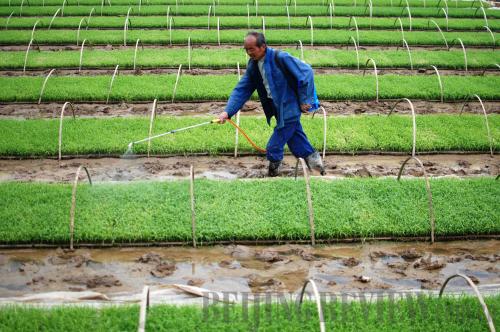|
 |
|
CULTIVATION Cao Naishui, a farmer from Jiujiang County, Jiangxi Province, waters rice on April 7 (YANG FENGSHENG) |
Trade Decline
China's exports went down 6.6 percent to $170.11 billion in March, customs data showed on April 10.
Imports went down 11.3 percent to $162.41 billion and total foreign trade volume declined 9 percent to $332.52 billion, the General Administration of Customs (GAC) said.
Trade balance returned to a surplus of $7.71 billion in March after a surprise deficit of $22.98 billion in the previous month, the GAC said.
Total trade volume of the first quarter stood at $965.88 billion, down 1 percent year on year. Of the total, exports declined 3.4 percent to $491.31 billion while imports grew 1.6 percent to reach $474.57 billion in the first quarter.
"Judging from data, China's foreign trade has encountered some difficulties. But we should never overestimate those difficulties," said Zheng Yuesheng, spokesman of the GAC.
"The decline in foreign trade data will be temporary and short-term. China's foreign trade will regain growth from May this year and then enter a mild growth period."
China's foreign trade still has several advantages, including global economic recovery, China's efforts in comprehensively deepening reforms and Chinese companies' surging overseas investment, Zheng said.
"It's likely that China will realize its 7.5-percent foreign trade growth target," he predicted.
Economic Circle
China's top economic planner, the National Development and Reform Commission (NDRC), announced on April 9 that it is drawing up a plan for the coordinated development of a Beijing-centered "economic circle."
The Beijing-centered circle is one of three economic growth poles in east China, and its progress will push forward the economic transformation and upgrading of the area surrounding the Bohai Sea, the NDRC said.
The NDRC said the draft will make use of the region's comparative advantages and bring about specific measures in infrastructure construction, industrial layout and innovation in the three areas.
It also vowed to strengthen ecological building practices and environmental protection, promote widely beneficial public services, and deepen reform and opening up. A mechanism for regional cooperation can also be expected in the plan.
The NDRC did not unveil when the plan will finally come out, saying it depends on the drafting progress.
The economic circle is home to over 100 million people and boasts a combined GDP of over 6 trillion yuan ($967.2 billion) with a total area of 216,000 square km.
Railway Investment
China will increase railway fixed asset investment to 720 billion yuan ($117.09 billion) in 2014, said Sheng Guangzu, General Manager of the China Railway Corp. (CRC).
Sheng said the corporation was increasing investment to meet demand. Forty-nine new projects and over 7,000 km of new railway lines will be put into operation this year.
The former plan set at the beginning of the year targeted 700 billion yuan ($113 billion) of fixed asset investment, 44 new projects and 6,600 km of new railway lines, according to the CRC.
Sheng said that 78 percent of all construction investment will go to the central and western regions, which will be the site of 86 percent of this year's newly operated railways.
According to a five-year plan from 2011 to 2015, 230,000 km of new railway lines will be built in central and western regions, with an investment of 1.85 trillion yuan ($300 billion).
Sheng said from 2011 to 2013, 1.15 trillion yuan ($190 billion) had been invested in the regions.
| 